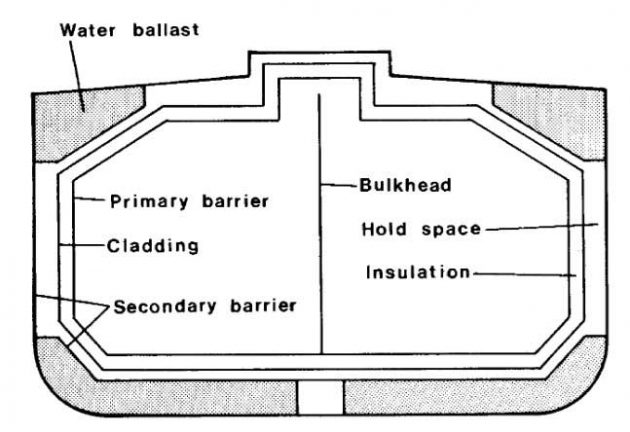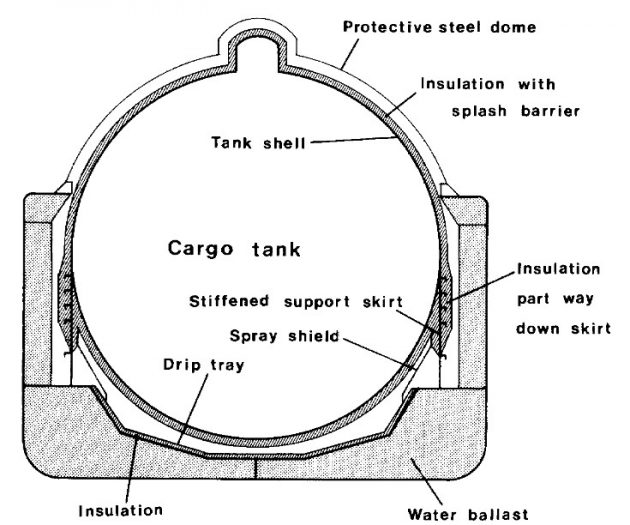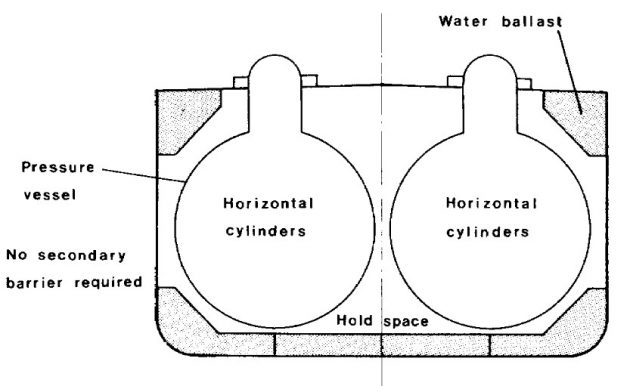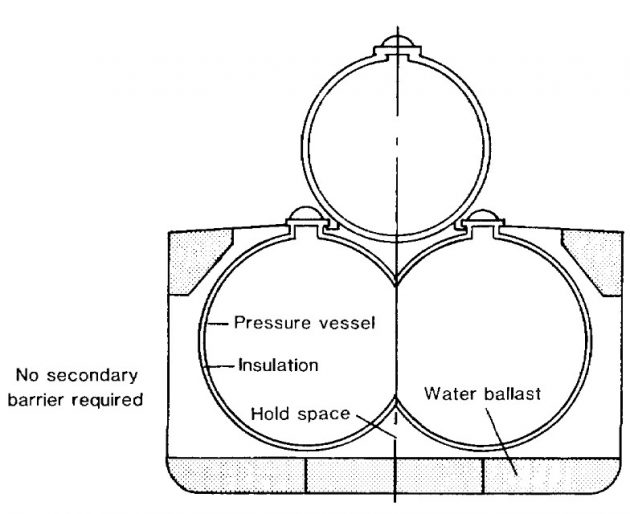This article contains information about types of tanks, what used frequently in cargo containment system when transporting on special ships – gas tankers.
- Independent tanks
- Independent tanks, type A (MARVS < 0. 7 bar)
- Independent tanks, type B (MARVS < 0. 7 bar)
- Independent tanks, type C (MARVS < 0. 7 bar)
- Membrane tanks (MARVS NORMALLY < 0.25 BAR)
- Semi-Membrane tanks (MARVS NORMALLY < 0.25 BAR)
- Integral tanks (MARVS NORMALLY< 0.25 BAR)
- Internal insulation tanks
Independent tanks
These types of tanks are completely self-supporting and do not form part of the ship’s hull and do not contribute to the hull strength. Depending mainly on design pressure, there are three different types of independent tanks for gas carriers, Types A, B and C.
Independent tanks, type A (MARVS < 0. 7 bar)
Independent tanks of type A are prismatic and supported on insulation-bearing blocks and located by anti-roll chocks and anti-flotation chocks. The tanks are normally divided along their centreline by a liquid-tight bulkhead; by this feature, together with the chamfered upper part of the tank, the free liquid surface is reduced and the stability is increased.

When these cargo tanks are designed to carry LPG (at -50 °C), the tank is constructed of fine-grained low-carbon manganese steel. The Conch design has been developed for carriage of LNG (at -163 °C). The material for these cargo tanks has to be either 9 % nickel steel or aluminium.
Independent tanks, type B (MARVS < 0. 7 bar)
Independent tanks of type B are normally spherical and welded to a vertical cylindrical skirt, which is the only connection to the ship’s hull. The hold space in this design is normally filled with dry inert gas but may be ventilated with air provided that inerting of the spaces can be achieved in the event of the vapour detection system detecting cargo leakage.

A protective steel dome covers the primary barrier above deck level, and insulation is applied to the outside of the primary barrier surface. This containment system has been used for carriage of LNG. The material of construction is either 9 % nickel steel or aluminium.
Independent tanks, type C (MARVS < 0. 7 bar)
Independent tanks of type C are cylindrical pressure tanks mounted horizontally on two or more cradle-shaped foundations. The tanks may be fitted on, below or partly below deck and be both longitudinally and transversely located.

To improve the poor utilization of the hull volume, lobe-type tanks are commonly used at the forward end of the ship. This containment system is used for LPG and LEG. The material, if used for the construction of tanks designed to carry ethylene, is 5 % nickel steel.

Membrane tanks (MARVS NORMALLY < 0.25 BAR)
Membrane tanks are not self-supporting tanks; they consist of a thin layer (membrane), normally not exceeding 1 mm thick, supported through insulation by the adjacent hull structure. The membrane is designed in such a way that thermal and other expansion or contraction is compensated for, and there is no undue stressing of it. The membrane design has been developed for carriage of LNG. The material of construction is lnvar steel (36 % nickel steel) or 9 % nickel steel.
Semi-Membrane tanks (MARVS NORMALLY < 0.25 BAR)
Semi-membrane tanks are not self-supporting; they consist of a layer which is supported through insulation by the adjacent hull structure. The rounded parts of the layer are designed to accommodate thermal expansion and contraction, and other types thereof. The semi-membrane design has been developed for carriage of LNG, and the material of construction is 9 % nickel steel or aluminium.
Integral tanks (MARVS NORMALLY< 0.25 BAR)
Integral tanks form a structural part of the ship’s hull and are influenced by the same loads which stress the adjacent hull structure, and in the same manner. This form of cargo containment is not normally allowed if the cargo temperature is below -10 °C. Today, this containment system is partly used on some LPG ships dedicated to the carriage of butane.
Internal insulation tanks
Thermal insulation must be fitted to refrigerated cargo tanks for the following reasons:
- To minimise heat flow into cargo tanks and thus reduce boil-off.
- To protect the general ship structure around the cargo tanks from the effects of low temperature.
For use aboard gas carriers insulation materials should process the following characteristics:
- Low thermal conductivity.
- Non-flammable or self-extinguishing.
- Ability to bear loads.
- Ability to withstand mechanical damage.
- Light weight.
- Material should not be affected by cargo liquid or vapour.
The material’s vapour-sealing properties to prevent ingress of water or water vapour is very important. Not only can ingress of moisture result in loss of insulation efficiency but progressive condensation and freezing can cause extensive damage to the insulation. Humidity conditions must therefore be kept as low as possible in hold spaces.
